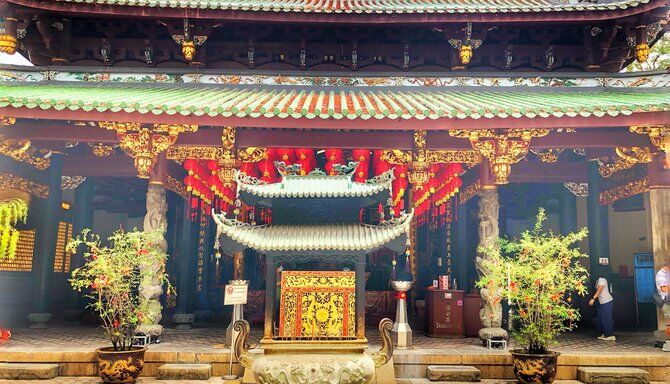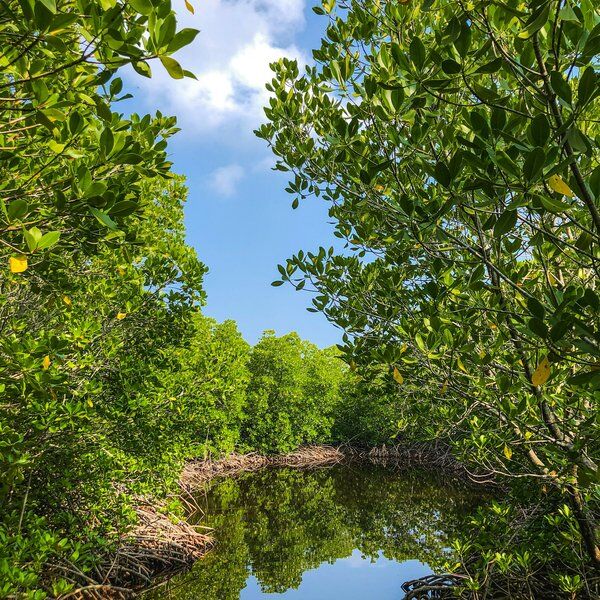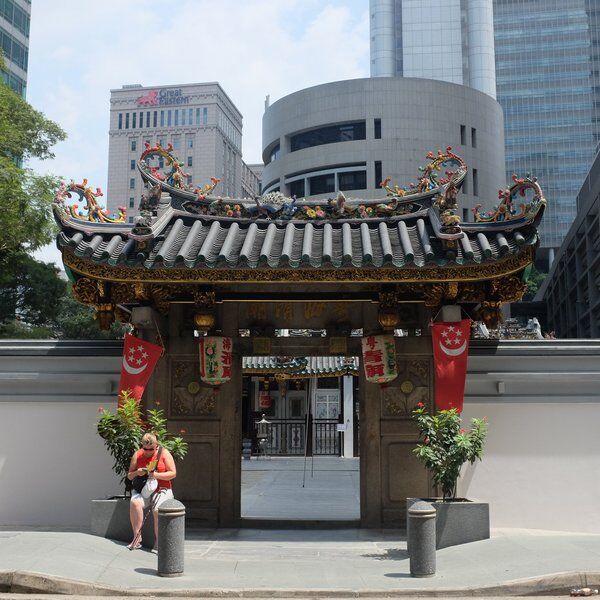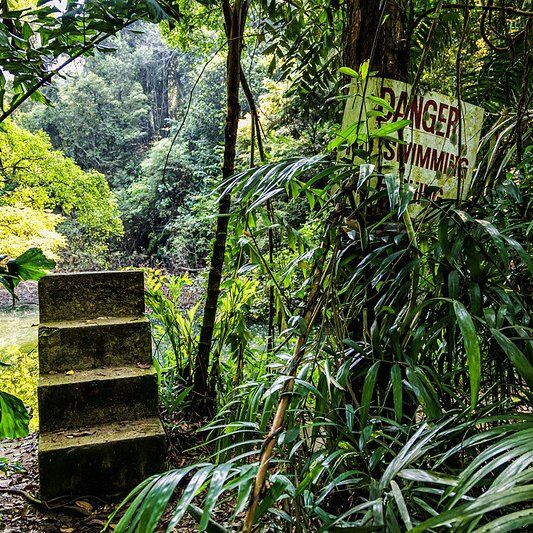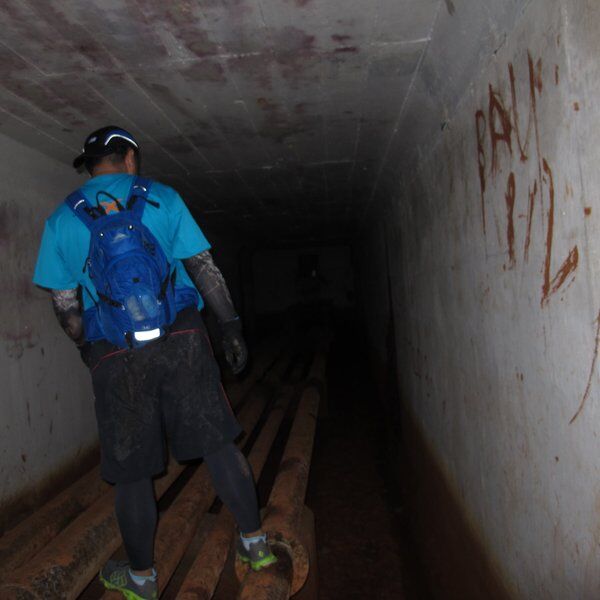Thian Hock Keng Temple is one of Singapore’s oldest and most significant Hokkien Chinese Temples. Located in Singapore's bustling and atmospheric Chinatown district, Thian Hock Keng Temple remains a place of worship and a historical landmark for those curious about Singapore’s vibrant history.
Thian Hock Keng Temple History
The history of Thian Hock Keng Temple is a fascinating tale that combines multiple cultures, ancient Chinese mythology, Fujian architecture and so much more.
Although the story of Thian Hock Keng Temple starts in the 19th century, aspects of it go back as far as the 10th century in China, specifically in the Zhangzhou and Quanzhou prefectures in the Fujian provinces. Read on to find out how 1000 years of history culminated in this marvellous historical landmark…
Singapore’s Early History: British Colonialism and Chinese Immigration
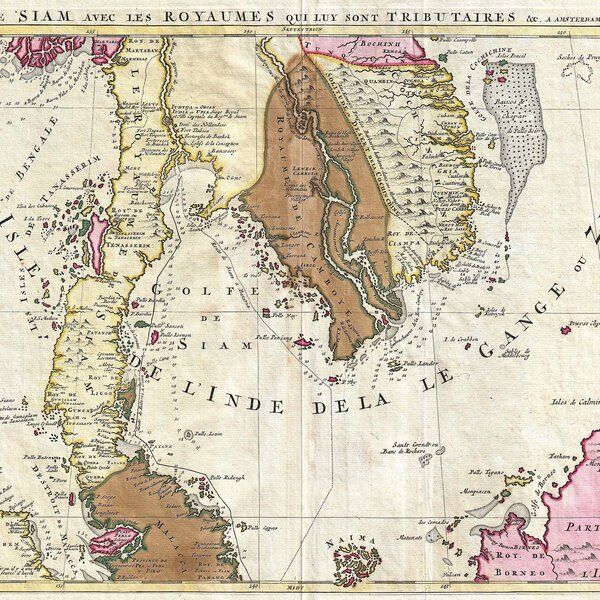
We begin our tale of Thian Hock Keng Temple on the 6th of February, 1819, when Sir Stamford Raffles established Singapore as a British colony. Raffles, an agent of the British East India Company, acquired Singapore as a British trading post through a treaty with the Sultan of Johor (south Malaysia).
Although Raffles’ name is the most famous European name associated with modern Singaporean history, much of the nation’s early development was largely delegated to a Scottish colonial administrator called William Farquhar.
Farquhar was made the first “Resident” or Governor of Singapore days after Raffles established the colony and it was he who set up the post that would fly the Union Jack in Singapore for the first time atop Bukit Larangan hill. Before receiving his post, Farquhar had spent a total of 23 years in Malaya, immersing himself in local and regional politics and even negotiating Raffles’ treaty with the Sultan.
Farquhar was a complicated man. His approach to governing Singapore was laissez-faire and business-oriented. Exponential economic growth was arguably his biggest motivation, something that would later be his downfall.
Some of his ideas were good: he paid a shilling for every rat killed in the colony to prevent an outbreak of cholera, improved roads and advocated for timber-framed houses to be built to sustain the rapidly growing population.
On the other hand, Farquhar was happy to turn a blind eye (and even allow) practices Raffles had expressly forbidden, including gambling, the sale of opium, cock-fighting and, worst of all, slavery. Farquhar argued that these practices improved the much-needed cash flow to the colony, while Raffles despised these ‘vices’ and dismissed Farquhar, who returned to Scotland in 1823 in disgrace.
Interestingly, William Farquhar has been identified as Justin Trudeau’s (the 23rd Prime Minister of Canada) 5th great-grandfather.
From The Province of Fuji to Singapore: The Beginnings of Thian Hock Keng Temple
Meanwhile, along the coast of southeastern China, rumours of a free British colony called Singapura (‘Lion City’) were circulating, brought by British sea traders who frequented the Fujian province.
These rumours couldn’t have come at a better time: within the first few decades of the 19th century, towns and villages along China’s southeastern coast had experienced floods, famines, droughts and civil unrest. The promise of a better life and improved circumstances enticed many young and able men to board ‘junk’ boats (Chinese sailships) and seek their fortunes across the South China Sea in Singapore, Britain’s newly established free trading post.
The British encouraged immigration from China and India to Singapore. Firstly, the city required many pairs of hands to build and develop the rapidly expanding number of homes and infrastructure. Secondly, the migrant workers from these nations were the cheapest alternative to help build the rapidly expanding number of homes and infrastructure required in the colony.
A large number of the early Chinese immigrants to Singapore came from Zhangzhou and Quanzhou prefectures in the Fujian province. These immigrants were the forerunners of the Hokkien community, named after their shared dialect (a variety of Chinese). Their arrival in Singapore marked the beginning of Buddhism in the nation, as well as the introduction of Ancient Chinese mythology.
In 1824, Singapore’s Chinese population was estimated to be around 3,317 people. By 1836, it had soared to 13, 749 - but there was a catch: the bulk of Chinese immigrants arriving in Singapore were single men between the ages of 15 and 40. This meant that in the same year, for every 1,000 women living in Singapore, there were 14, 642 men!
Despite the disparity in numbers between men and women, Singapore’s population continued to grow. Thirteen years later in 1849, Chinese descendants or immigrants made up the majority of the population for the first time.
Thian Hock Keng Temple: An Ode to Mazu
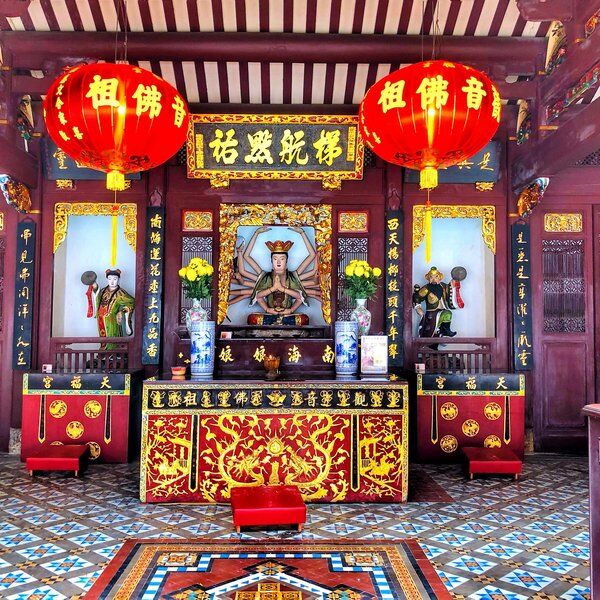
Thian Hock Keng Temple is mainly dedicated to Mazu, the Goddess of the Sea in Ancient Chinese mythology.
Mazu is believed to have been a real person, a shamaness from a Fujian fishing village named Lin Moniang. Born in 960 AD, Lin had four brothers and came from a hard working family where her father worked as a fisherman.
Lin was an unusual child: it’s said that when she was born, she didn’t cry or make a sound. She remained mute throughout her life but was spiritually gifted; she was able to forecast the weather and even predict the future.
Accordingly, myths involving Lin tend to focus on her abilities to foresee outcomes and her supernatural abilities to predict nature. One of the most prominent Chinese myths involving Lin sees Lin’s father and brothers heading out to sea and being caught in a terrible storm. Lin gets a vision of her father and brothers drowning and enters a trance in a bid to save them. Lin’s mother, unaware of why her daughter has seemingly become paralysed, shakes her out of the trance. As a result, Lin is unable to save her father and brothers and throws herself from a cliff into the sea. As she reaches the water’s surface, her body is transferred to heaven through a beam of light, signalling her reincarnation as the Goddess Mazu.
Etymologically, Mazu is a compound of ‘mā’ (meaning ‘mother’) and ‘zǔ’ (‘ancestor’). Mazu is referred to by many names, both formal and informal, and it’s said that those hoping to invoke Mazu’s help are advised to pick wisely according to the severity of their problem: using a formal name will provoke Mazu into taking a while to respond, owing to her need to dress up formally before responding to the inquirer’s problem.
In 2009, UNESCO added Mazu Belief and Culture to the Representative List of the Intangible Cultural Heritage of Humanity.
The Construction of Thian Hock Keng Temple
During the 19th century, the only way of reaching Singapore from mainland China was by vessel. For the travellers from the Fujian province, it was paramount that Mazu, as Goddess of the Sea, was revered and thanked for their safe passage.
Accordingly, as early as 1822, a predecessor to the Thian Hock Keng Temple was erected by Chinese immigrants to serve the local Hokkien community. It took the form of a small joss house, where fishermen, travellers and newly-arrived immigrants could thank Mazu and pray for their families and friends.
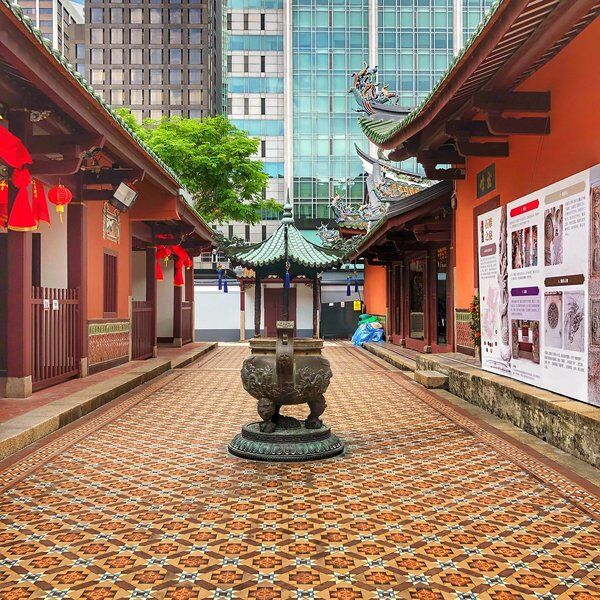
However, the joss house was not nearly large - or grand - enough to accommodate the rapidly growing Hokkien community in Singapore. In 1839, the Hokkien community crowdfunded the purchase of the land and erection of what was to become Thian Hock Keng Temple, donating what they could to revere their homeland’s heroine as she deserved. One of the largest donors was Tan Tock Seng, a successful businessman who also hailed from the Fujian province.
The new temple was meticulously designed and planned for, the bulk of the building materials and decorations were imported from China, including a statue of Mazu. Since it was the first Buddhist temple of its kind in Singapore, builders and craftsmen were brought over from the Fujian province to oversee the construction of Thian Hock Keng Temple.
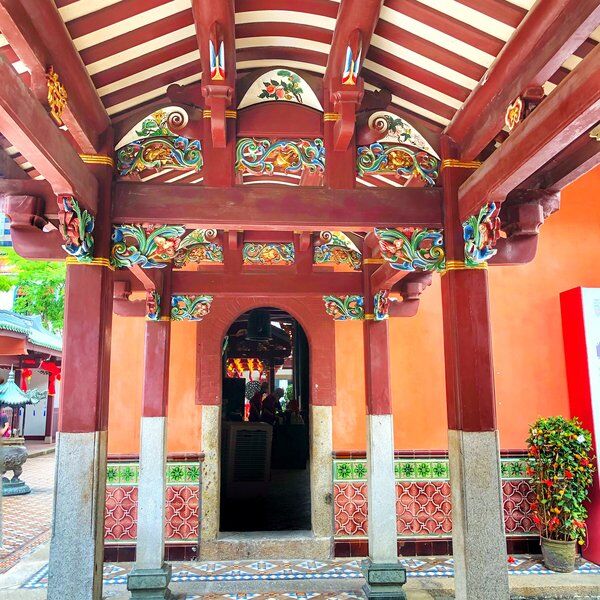
After it was completed in 1840, Thian Hock Keng Temple was used as the headquarters for the Singapore Hokkien Huay Kuan (SHHK), a clan association that was formed to discuss the social needs of the Chinese community in Singapore. As the first of these clans, the SHHK accommodated Chinese immigrants from all backgrounds, not just Hokkien, before the creation of other clan associations.
Amazingly, the temple was built according to ancient Chinese practices that involve slotting various parts of the building together without the use of nails.
Thian Hock Keng Temple: A Multicultural Creation
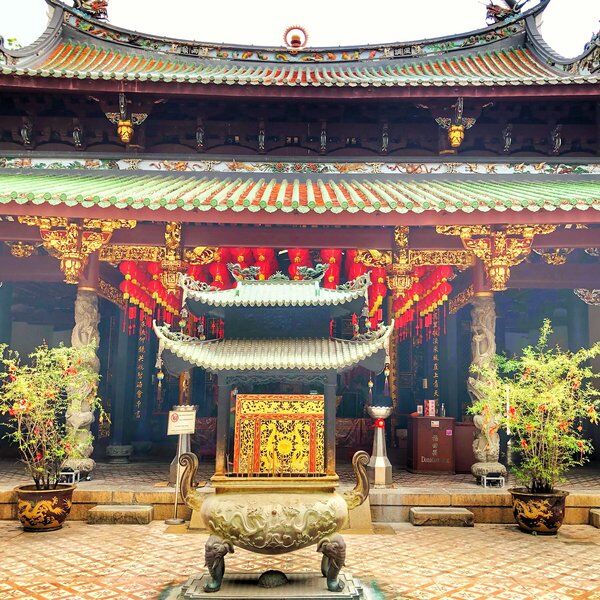
Although Thian Hock Keng Temple is a quintessentially Fujian temple, there are a few subtle nods to other countries and cultures - if you know where to look.
Initially, when Britain acquired the country as a trading post, the majority of Singapore’s population were indigenous Malay Singaporeans or Orang Laut peoples. Like today, the Malay Singaporeans adhered to Islam, and peacefully accepted their new Chinese neighbours who brought Buddhism with them from China.
At the same time, a small Indian diaspora group was growing in the nation. Many of them were Tamil Muslims, originally from India, known locally as the Chulia community. Some of the Chulia community contributed to the construction of Thian Hock Keng Temple - eagle-eyed visitors will notice an Indian figure buttressing a roof beam in the right wing of the temple, a nod to the community’s involvement in the project.
Finally, the temple’s presence in a former British colony is also visible. In 1906, the temple received a wrought iron gate imported from Glasgow, Scotland, to protect the structure’s complex.
Thian Hock Keng Temple: See and Do
Today, Thian Hock Keng Temple is a place of worship that combines buddhism, taoism, confucianism and ancestral worship, making it a significant place for many different people.
Thian Hock Keng Temple also operates as a cultural heritage site, offering visitors and residents alike an insight into the nation’s Chinese heritage and traditions in Singapore.
Throughout the year, Thian Hock Keng Temple hosts a variety of events to celebrate significant dates such as Chinese New Year and Mazu’s Birthday Celebration.
The temple is world-renowned for its exquisite architecture and it’s well-worth a visit for history buffs and architecture-admirers alike: keep an eye out for vibrant ceramic tiles, dragon and phoenix sculptures and other ornate statues within the temple.
Discover More of Singapore With CityDays
Ready to discover more of what Singapore has to offer?
CityDays have a brand new treasure and scavenger hunt in Singapore which combines the fun of an escape room with the historic facts and whimsical trivia of a walking tour!
Take the stress out of planning your visit to Singapore and book your adventure today!
Not visiting Singapore this time? Don’t worry, you’ll find us all over the world.
